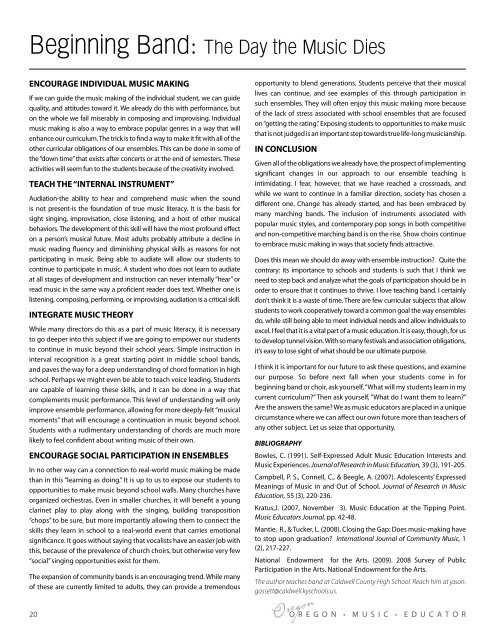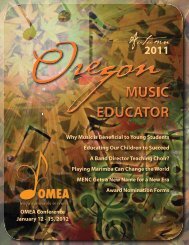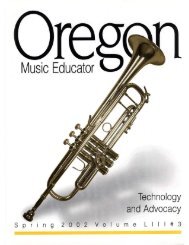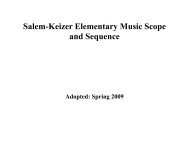OMEA Spring 2013 web.pdf - Oregon Music Education Association
OMEA Spring 2013 web.pdf - Oregon Music Education Association
OMEA Spring 2013 web.pdf - Oregon Music Education Association
Create successful ePaper yourself
Turn your PDF publications into a flip-book with our unique Google optimized e-Paper software.
Beginning Band: The Day the <strong>Music</strong> DiesENCOURAGE INDIVIDUAL MUSIC MAKINGIf we can guide the music making of the individual student, we can guidequality, and attitudes toward it. We already do this with performance, buton the whole we fail miserably in composing and improvising. Individualmusic making is also a way to embrace popular genres in a way that willenhance our curriculum. The trick is to find a way to make it fit with all of theother curricular obligations of our ensembles. This can be done in some ofthe “down time” that exists after concerts or at the end of semesters. Theseactivities will seem fun to the students because of the creativity involved.TEACH THE “INTERNAL INSTRUMENT”Audiation-the ability to hear and comprehend music when the soundis not present-is the foundation of true music literacy. It is the basis forsight singing, improvisation, close listening, and a host of other musicalbehaviors. The development of this skill will have the most profound effecton a person’s musical future. Most adults probably attribute a decline inmusic reading fluency and diminishing physical skills as reasons for notparticipating in music. Being able to audiate will allow our students tocontinue to participate in music. A student who does not learn to audiateat all stages of development and instruction can never internally “hear” orread music in the same way a proficient reader does text. Whether one islistening, composing, performing, or improvising, audiation is a critical skill.INTEGRATE MUSIC THEORYWhile many directors do this as a part of music literacy, it is necessaryto go deeper into this subject if we are going to empower our studentsto continue in music beyond their school years. Simple instruction ininterval recognition is a great starting point in middle school bands,and paves the way for a deep understanding of chord formation in highschool. Perhaps we might even be able to teach voice leading. Studentsare capable of learning these skills, and it can be done in a way thatcomplements music performance. This level of understanding will onlyimprove ensemble performance, allowing for more deeply-felt “musicalmoments” that will encourage a continuation in music beyond school.Students with a rudimentary understanding of chords are much morelikely to feel confident about writing music of their own.ENCOURAGE SOCIAL PARTICIPATION IN ENSEMBLESIn no other way can a connection to real-world music making be madethan in this “learning as doing.” It is up to us to expose our students toopportunities to make music beyond school walls. Many churches haveorganized orchestras. Even in smaller churches, it will benefit a youngclarinet play to play along with the singing, building transposition“chops” to be sure, but more importantly allowing them to connect theskills they learn in school to a real-world event that carries emotionalsignificance. It goes without saying that vocalists have an easier job withthis, because of the prevalence of church choirs, but otherwise very few“social” singing opportunities exist for them.The expansion of community bands is an encouraging trend. While manyof these are currently limited to adults, they can provide a tremendousopportunity to blend generations. Students perceive that their musicallives can continue, and see examples of this through participation insuch ensembles. They will often enjoy this music making more becauseof the lack of stress associated with school ensembles that are focusedon “getting the rating.” Exposing students to opportunities to make musicthat is not judged is an important step towards true life-long musicianship.IN CONCLUSIONGiven all of the obligations we already have, the prospect of implementingsignificant changes in our approach to our ensemble teaching isintimidating. I fear, however, that we have reached a crossroads, andwhile we want to continue in a familiar direction, society has chosen adifferent one. Change has already started, and has been embraced bymany marching bands. The inclusion of instruments associated withpopular music styles, and contemporary pop songs in both competitiveand non-competitive marching band is on the rise. Show choirs continueto embrace music making in ways that society finds attractive.Does this mean we should do away with ensemble instruction? Quite thecontrary: its importance to schools and students is such that I think weneed to step back and analyze what the goals of participation should be inorder to ensure that it continues to thrive. I love teaching band. I certainlydon’t think it is a waste of time. There are few curricular subjects that allowstudents to work cooperatively toward a common goal the way ensemblesdo, while still being able to meet individual needs and allow individuals toexcel. I feel that it is a vital part of a music education. It is easy, though, for usto develop tunnel vision. With so many festivals and association obligations,it’s easy to lose sight of what should be our ultimate purpose.I think it is important for our future to ask these questions, and examineour purpose. So before next fall when your students come in forbeginning band or choir, ask yourself, “What will my students learn in mycurrent curriculum?” Then ask yourself, “What do I want them to learn?”Are the answers the same? We as music educators are placed in a uniquecircumstance where we can affect our own future more than teachers ofany other subject. Let us seize that opportunity.BIBLIOGRAPHYBowles, C. (1991). Self-Expressed Adult <strong>Music</strong> <strong>Education</strong> Interests and<strong>Music</strong> Experiences. Journal of Research in <strong>Music</strong> <strong>Education</strong>, 39 (3), 191-205.Campbell, P. S., Connell, C., & Beegle, A. (2007). Adolescents’ ExpressedMeanings of <strong>Music</strong> in and Out of School. Journal of Research in <strong>Music</strong><strong>Education</strong>, 55 (3), 220-236.Kratus,J. (2007, November 3). <strong>Music</strong> <strong>Education</strong> at the Tipping Point.<strong>Music</strong> Educators Journal, pp. 42-48.Mantie, R., & Tucker, L. (2008). Closing the Gap: Does music-making haveto stop upon graduation? In ternational Journal of Community <strong>Music</strong>, 1(2), 217-227.National Endowment for the Arts. (2009). 2008 Survey of PublicParticipation in the Arts. National Endowment for the Arts.The author teaches band at Caldwell County High School. Reach him at jason.gossett@caldwell.kyschools.us.<strong>Oregon</strong>20 O R E G O N ∙ M U S I C ∙ E D U C A T O R






